Key highlights
- Learn the full process of how to start a podcast, from concept and setup to hosting, promotion and monetization.
- Understand the essential tools and steps to create a podcast, record, edit and produce quality audio or video episodes.
- Explore how to distribute your show on major platforms and grow it with a website, SEO and email signups while starting a podcast.
- Know the best ways to make a podcast profitable in 2025 through sponsorships, ads, affiliates and premium content.
- Uncover how to track success with downloads, engagement and podcast analytics while publishing a podcast consistently to grow your audience.
Podcasting has evolved from a niche hobby into a global media powerhouse. It garners millions of new listeners tuning in daily for entertainment, news, education and more.
The podcasting landscape is more dynamic and accessible than ever in 2025. It is a perfect time to learn how to start a podcast and create content that not only has a strong audio quality but stands out for its engaging format.
Whether you’re an aspiring creator, an entrepreneur looking to expand your reach or simply passionate about sharing your voice through an interview podcast, this article covers you.
We’ll walk you through everything you need to know to launch a successful podcast. You’ll learn everything from brainstorming episode ideas and designing compelling cover art to learning how to invite guests and outreach new listeners across every major podcast player.
We’ll guide you on building a show that resonates with your audience and turning it into a valuable blog post or digital brand asset.
Why should you start a podcast?
You should start a podcast because it’s one of the most effective and affordable ways to build an audience, grow your brand and generate income. Podcasting lets you share your voice, connect with listeners on a deeper level, and establish authority in your niche — all while keeping startup costs low.
In fact, 46% of weekly podcast listeners have purchased a product or service after hearing an ad on a podcast. This highlights the medium’s ability to influence consumer behavior. Hence, podcasting is a highly effective tool for outreach.
With major platforms like Google Podcasts, Apple Podcasts, and YouTube, anyone can reach a global audience through either audio or video formats.
Let us now gain a deeper understanding of why you should start a podcast.
5 reasons to start a podcast
1. Build an online audience and brand authority
When you create a podcast, you get an excellent opportunity to establish a loyal listener base around a specific topic.
By posting podcast episodes consistently, you not only build an online audience but also strengthen brand authority by positioning yourself as an expert in your field. Sharing your show on social media further boosts community engagement and organic reach.
2. Promote your product/service
If you’re wondering how to make a podcast that supports your business, consider using it as a platform to educate listeners about your offerings. Discuss product use cases, industry trends or customer success stories.
This approach naturally integrates marketing into valuable content, making your brand memorable without sounding promotional.
3. Make money
Podcasts open multiple monetization opportunities. As a content creator, you can generate income through brand sponsorships, ads or listener donations. Additionally, with the rise of video podcasts on platforms like YouTube, you can tap into YouTube’s many podcast monetization options, such as ad revenue and Super Chats.
4. Start affordably with low setup costs
One major reason to start a podcast is its low barrier to entry. You only need basic recording equipment, a reliable hosting platform and free or inexpensive editing software.
Compared to other forms of media, podcasting offers exceptional ROI and scalability, letting you grow naturally as your audience expands.
5. Measure success through podcast analytics
Modern podcast hosting platforms make it easy to track performance with podcast analytics. You can monitor listener growth, downloads, and engagement to refine your content strategy.
This data-driven feedback helps you produce better episodes, maintain podcast consistency and achieve long-term success.
How to start a podcast – 12 key steps involved in building your podcast
To start a podcast, you need more than just hitting record. It takes planning, creativity and consistency.
In short, learning how to create a podcast is about striking a balance between creativity and strategy. You must know your audience to produce valuable content and maintain a steady publishing rhythm.
Whether you’re an individual creator or a brand, starting a podcast can help you build authority, connect with listeners and generate income through sponsorships or ads.
Here are the 12 essential steps on how to start a podcast, from setup to audience growth.
- Develop a podcast concept
- Choose a podcast format
- Select your podcasting equipment
- Plan your first podcast episode
- Record your first episode
- Create an intro and outro
- Edit your podcast
- Upload episodes to a podcast host
- Get listed in podcast directories
- Create a podcast website
- Generate some buzz
- Monetize your podcast
Let us explore each step in detail:
Step 1: Develop a podcast concept
The first step in creating a successful podcast is to define its purpose. Before you begin recording, it’s essential to understand why you’re starting the podcast.
Are you looking to share valuable insights, connect with a community or build your brand? Steven Bartlett, host of the popular Diary of a CEO podcast, emphasizes the importance of having a clear purpose. Diary of a CEO has become a prime example of how a podcast, rooted in authenticity and a strong sense of purpose, can resonate with listeners and grow into a successful platform.
Defining your podcast’s core mission from the outset will help guide your content, connect with your audience and ultimately set the stage for long-term success. To start the momentous tasks of building a successful podcast, you must have a firm perspective on the below pointers:
- What are your goals: Do you want to use your podcast to attract new customers, build authority in your industry or make money from it?
- Pick a theme you’re passionate about: You’ll be discussing your topic a lot, so it’s important to pick something you enjoy and can talk about from different angles. This is especially important when selecting your podcast niche, as focusing on a specific niche helps you stand out and attract a more targeted audience.
- Research the competition: Listen to a few episodes from other audio or video podcasts that cover similar topics to see what’s already being discussed. Think about how you can bring something fresh and exciting to the table.
- Stand out in the crowd: Consider how you can use your voice and fresh perspectives to make your podcast unique. Passion for your subject will also help prevent “podfade,” – when a podcast stops producing after just a few episodes.
Step 2: Choose a Podcast Format

Next, you’ll decide on the format of your podcast. Here’s what to think about:
- Solo or with others: Do you want to run the show yourself or would you prefer to bring in guests or a co-host? If you choose a co-host, make sure they’re passionate about the topic and that you work well together. Podcast interviews can be a great way to engage with experts and attract a larger audience.
- What type of podcast will you create: Many options include interviews, news recaps, storytelling or informational podcasts. You can even create a video podcast on YouTube or keep it simple with audio. Some podcasters choose to do both, offering audio and a YouTube podcast to reach a wider audience.
- How long will each episode be: The length of your podcast is important. Many podcasts are 20-40 minutes long, but video podcasts are usually longer. Pick a length that works for you and your audience.
Step 3: Select your podcasting equipment
You don’t need to spend much on equipment to start a podcast studio. Here are the basics:
- Microphone: This is the most important piece of podcast equipment. Poor audio will drive listeners away. A dynamic mic is best for beginners because it picks up less background noise and is easier to use than a condenser mic.
- Mic accessories: Consider getting a pop filter to reduce noise from your mouth and a shock mount to avoid vibrations.
- Recording and editing software: To record your podcast, use Zencastr (free) or Audacity (free) for editing. If you want something more advanced, Adobe Audition is a paid option. For Mac users, GarageBand is a great free option. If you’re doing a video podcast, you’ll also need to consider software that supports video recording, such as OBS Studio or Camtasia.
Step 4: Plan your first podcast episode
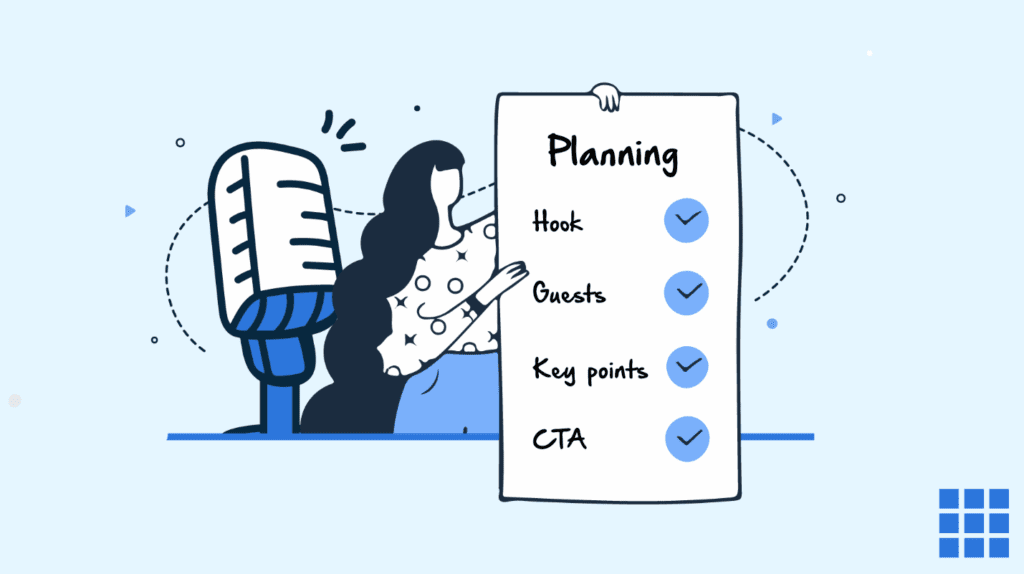
Before you hit record, planning a podcast outline for your first episode is a good idea. An outline will help you stay on track, avoid rambling and cover all the important points you want to discuss. You don’t need to write a full script; jot down the key points you want to touch during the episode.
1. What’s the goal of this episode?
Start by thinking about the main goal of the episode. Are you looking to explain something in detail, share an exciting story or present an opinion on a topic? Knowing the purpose of your episode will help keep your content focused and ensure you provide value to your listeners.
2. Add a hook
Next, plan a hook that will grab your audience’s attention immediately. This could be a surprising fact, a question or a brief anecdote that makes listeners want to keep listening. It’s important to make a strong first impression so they stay engaged.
3. Guest introduction
If you have a guest on the show, introduce them at the beginning. Give a brief overview of who they are, their expertise and what they’ll share during the episode. This will set the stage for your listeners and help them understand why your guest’s insights are valuable.
4. Key points
Then, outline the key points or questions you want to address during the episode. If you’re interviewing someone, list the questions you want to ask or make a note of the topics you want to cover. This ensures you don’t forget important details and helps guide the conversation smoothly.
5. Call to action (CTA)
Finally, end your episode with a clear call to action (CTA). Encourage your listeners to subscribe, follow you on social media, visit your website or check out your other episodes. A strong CTA helps build your audience and keeps them connected with you beyond the episode.
Step 5: Record your first episode
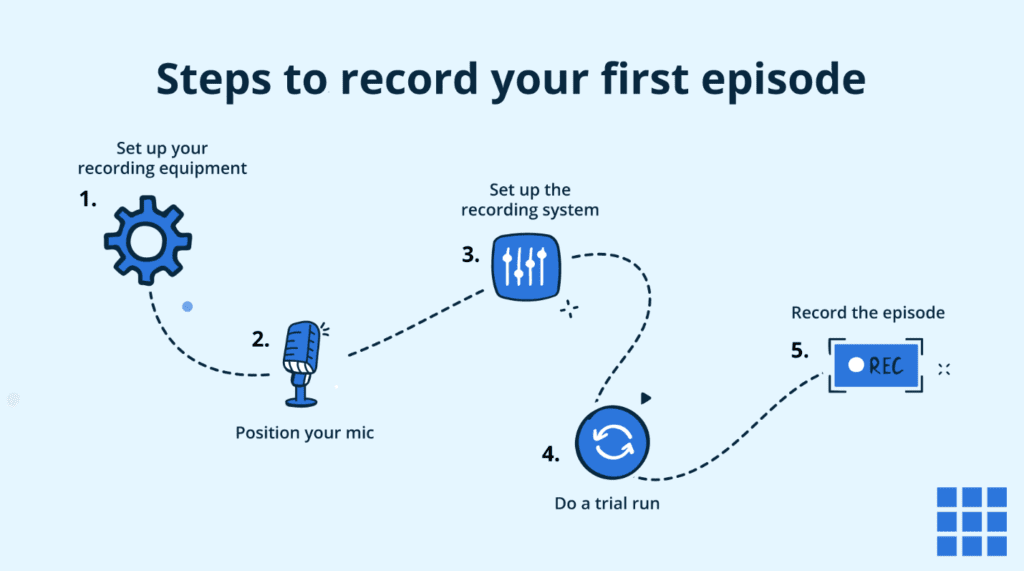
When you’re ready to record:
1. Find a quiet space
Start by choosing the right space. It is essential to find a quiet room where you can record without interruptions. A room with soft surfaces, like carpets, curtains and furniture, will help absorb sound and reduce echoes.
This is especially important when recording an audio or video podcast, as clear sound is key to keeping your listeners engaged.
2. Set up your mic and recording software
Next, set up your podcast equipment. Connect your microphone to your computer and make sure it’s working correctly. Depending on your chosen podcast or video format, you might also need a camera to create a video podcast for your YouTube channel.
Open your recording software and adjust the settings to ensure you’re recording audio files in high-quality formats like WAV or MP3.
These formats will give you the best sound quality for your audio podcasts and make it easier to upload your episodes to podcast platforms like Google Podcasts or other directories.
3. Do a test recording
Doing a test run before you start your main recording is a good idea. Record a short sample and play it back to check for sound issues like background noise or distortion.
This is also a great opportunity to test your microphone placement, ensure it’s at the right distance from your mouth and adjust the volume levels if needed.
If you’re doing a podcast interview, test the microphone with your guest beforehand to ensure both voices are clear.
4. Start recording
Once you’re satisfied with the sound quality, it’s time to start recording your full episode. Don’t worry too much about making mistakes or having a few pauses. You can edit those out later when compiling your podcast description and uploading your episode.
This can be done when editing the full audio file or uploading audio files to platforms like Google Podcasts or your YouTube podcast channel.
The most important thing is to keep your flow going and focus on delivering valuable content for your listeners.
Step 6: Create an intro and outro
Your intro and outro are your listeners’ first and last impressions of each episode, so making them count is important.
Keep them short, clear and engaging while staying true to your podcast’s tone and style.
Podcast intro
For your podcast intro, start with a catchy opening that quickly communicates the essence of your podcast.
In about 30 seconds or less, explain to listeners what to expect from the podcast episode and why they should tune in. If you want to add a personal touch, consider including podcast music that aligns with your podcast cover art or theme.
Don’t forget to mention the podcast title in your intro so that listeners know exactly what they’re listening to, especially if you’re promoting your show across various podcast platforms.
Podcast outro
For your podcast outro, thank your audience for tuning in and reminding them of the action you’d like them to take next.
Encourage them to subscribe so they don’t miss future episodes, share the episode with others or check out your podcast app or website for more information.
Step 7: Edit your podcast

Editing is where you fine-tune your podcast to make it sound professional and engaging.
It’s your opportunity to remove unnecessary distractions and ensure your listeners enjoy a smooth, seamless experience.
Trim the extra stuff
Start by trimming the extra stuff. Go through your podcast episode and remove any long pauses, filler words or mistakes that may have slipped in during the recording.
You want your content to flow naturally, so cutting out anything that doesn’t add value will keep your listeners engaged. If there are sections where you repeat yourself or drift off-topic, these are prime areas to edit out.
Background music
Next, consider the background music. Adding a little podcast music can set the tone for your episode, but be mindful of the volume level.
You want the music to enhance the atmosphere without overshadowing your voice. Keep it subtle so that it complements your message, not competes with it.
Export your episode
Once your edits are done, it’s time to export your episode. Save the finished version in a high-quality format, such as MP3, using settings like a 44.1 kHz sample rate and a 128 kbps bitrate for optimal sound quality.
If you plan to upload your podcast episode to various podcast platforms, these settings ensure your audio sounds crisp and clear across all devices.
You can also include your podcast title and any relevant links or information in the episode description to help listeners find your show and learn more about the topics you cover.
Step 8: Upload episodes to a podcast host
Once your podcast episode is polished and ready to go, the next step is to upload it to a podcast platform. However, you can’t upload directly to popular platforms like Google Podcasts or Spotify.
Instead, you’ll need to use a podcast hosting platform to store your episodes and distribute them across multiple platforms. Choosing the right podcast host is crucial, as countless options are available.
It’s important to research each platform and evaluate how it can help you express your message while supporting your goals, like selling products online. Here are some of the best podcast hosting platforms for selling your products effectively.
Podcast hosting platforms allow you to upload your podcast episodes, manage your content and share it with listeners on various platforms.
These services also offer essential tools for managing podcast artwork, the audio interface, editing tools tracking performance and ensuring your episodes are available for download or streaming.
Top podcast hosting platforms to consider
1. Libsyn
One of the most well-known and budget-friendly podcast hosting services. It starts at just $5/month and provides all the basic editing tools to upload and share your podcast episodes.
Libsyn also offers customizable options for your episode-length podcast title, allowing you to easily brand your show.
2. Blubrry
Starting at $12/month, Blubrry offers additional features such as podcast analytics, promotion tools, detailed statistics and marketing options.
It’s a great choice if you’re looking to grow your audience and track the performance of your episodes. Blubrry also allows you to manage your podcast recording and distribution across multiple platforms, including Google Podcasts and Spotify.
3. Alitu
While on the more expensive side, starting at $38/month, Alitu offers an all-in-one solution for podcasters.
In addition to hosting, Alitu provides built-in podcast editing software and recording tools, saving you time and effort.
If you want to create professional-quality podcast episodes and streamline your production process, Alitu is a solid option.
Step 9: Get listed in podcast directories
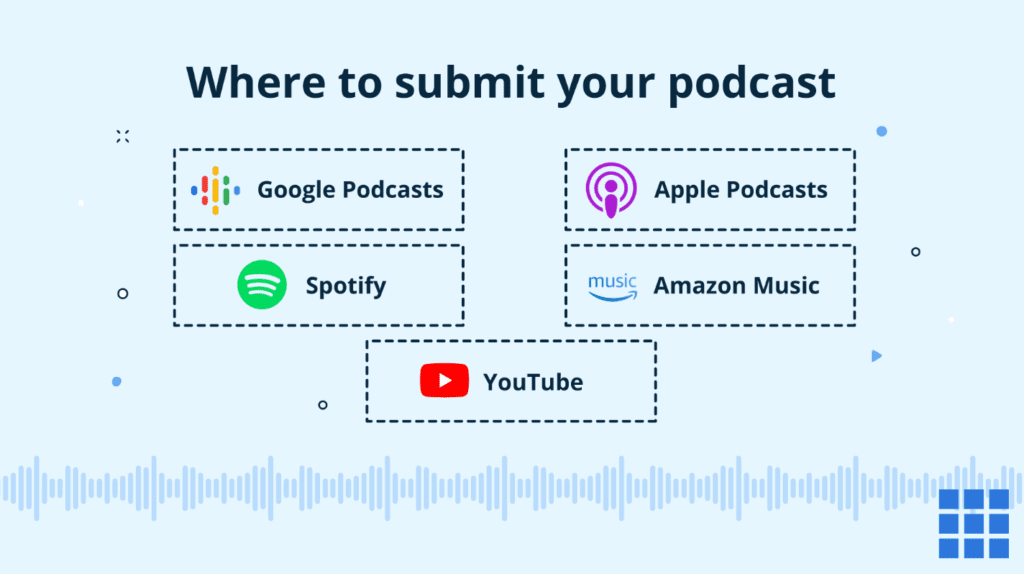
Once your podcast episodes are uploaded and ready, the next step is to list them in podcast directories so listeners can easily find them and tune in.
Some of the biggest and most popular directories include:
Apple Podcasts, Spotify and Google Podcasts
These platforms are essential for podcast discoverability.
Getting your podcast episodes listed here will make it easier for listeners to find your content, whether they’re searching by podcast title or browsing topics within your podcast niche.
YouTube
A YouTube account is a must if you’re producing a video podcast. As the most popular podcast platform, it offers massive visibility and the ability to engage with viewers who prefer watching podcasts over listening. A YouTube podcast channel can help expand your audience and grow your podcast.
When submitting your podcast to directories, remember to add essential details, like your podcast description, title and episode details. This will help listeners understand your podcast and why they should tune in.
By getting listed in multiple directories, you can increase the reach of your podcast episodes and improve your chances of attracting new subscribers.
Step 10: Create a podcast website

Having a dedicated website for your podcast is a powerful tool for promoting your content and building a stronger connection with your audience.
A podcast website serves as a central hub where listeners can access your podcast episodes, learn more about your podcast’s theme and stay updated with your latest releases.
For a fast and reliable website setup, consider using WordPress to host your podcast site. With Bluehost as your hosting provider, you can easily manage your podcast content and customize your site. WordPress offers perfect themes for podcasts, so you can showcase your podcast logo and artwork, include your podcast title and effectively promote your podcast recording.
To make the most of your own podcast app or website, here are a few key features you should include:
Upload show notes
Add detailed summaries, episode highlights and extra information about your podcast episodes. This is where you can share links, guest information and any resources mentioned in your episodes. It helps keep your podcast content more organized and provides value to your listeners.
Include a media player
Make it easy for listeners to stream your podcast episodes directly from your website. An embedded media player or podcast software ensures they don’t have to leave your site to enjoy your content. It’s also a great way to increase the engagement rate of your podcast.
Add a signup form
Encourage your audience to subscribe to your email list so they never miss an update. You can send them new episode alerts, podcast news or exclusive content. This helps grow your community and keeps your listeners engaged.
By building a dedicated website, you’re not just creating a place to host your episodes; you’re enhancing your podcast promotion strategy. Furthermore, you are also offering value to your listeners and making it easy for them to stay connected with your podcast.
Built-in SEO tools:
Video SEO tools and Bluehost’s Yoast SEO optimize search rankings of podcast websites by improving keywords, metadata and readability, ultimately improving search rankings. These tools enhance audio and video content visibility and attract more listeners and viewers.
Step 11: Generate some buzz
Before you officially launch your podcast, generating excitement and anticipation around your content is important.
Building buzz before your first episode drops will help you attract listeners from day one and get the word out about your podcast.
Here are a few ways to create that buzz:
1. Promote on social media
Leverage your social media accounts to build anticipation. Share teasers of your upcoming podcast episodes, including sneak peeks of the podcast recording, snippets from your first podcast episode or fun behind-the-scenes content.
This not only gives potential listeners a taste of what’s coming but also gives them a chance to connect with you. You can also post your own podcast cover artwork and title to make your content more visually appealing and shareable.
2. Collaborate with others
Collaborations are a great way to amplify your reach. Work with other podcasters or influencers in your podcast niche to cross-promote each other’s content.
You can do this through joint podcast interviews, guest appearances or shoutouts on each other’s social media platforms.
This kind of collaboration helps you tap into new audiences who might be interested in your podcast episodes.
3. Run ads
If you want to give your launch a little extra boost, consider running social media ads or reaching out to publications and blogs in your niche for coverage.
Paid ads on platforms like Facebook, Instagram or even Google can help you target the right audience and increase awareness of your podcast episodes. You can use your podcast episode title and artwork to create eye-catching ads that grab attention and encourage listeners to subscribe.
Building anticipation before your launch is a key part of podcast promotion. By creating buzz on social media, collaborating with others and using paid ads, you’ll be well on your way to establishing a loyal following for your podcast.
Step 12: Monetize your podcast
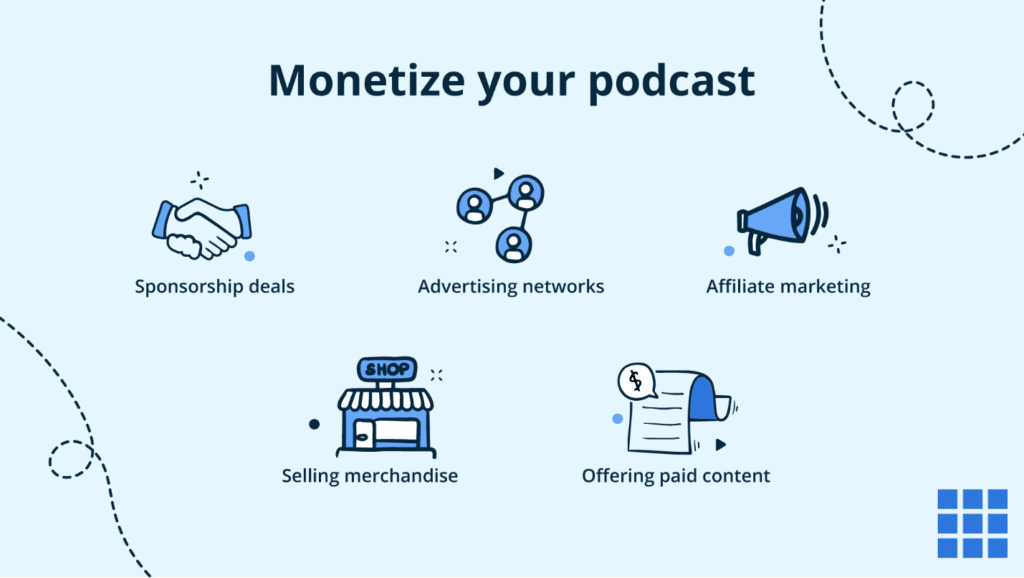
Once you’ve built a dedicated audience for your podcast, you can monetize your content. There are several ways to generate income from your podcast episodes and it’s important to explore options that best fit your podcast style and audience. Here are a few ways to start making money:
Sponsorships
Companies are often eager to partner with podcasters to promote their products or services. With a strong listener base, you can attract sponsorships where brands pay you to mention them in your podcast episodes.
Sponsorship deals can range from product shoutouts to longer ad spots within your podcast. Choose sponsors that align with your podcast niche and values, as this will resonate better with your listeners.
Advertising
Another way to monetize your podcast episodes is to join an ad network. Platforms like Midroll or AdvertiseCast allow advertisers to place ads in your episodes.
You typically earn money based on the number of listeners, with payment calculated per thousand listeners (CPM). As your video podcasting or audio recording show grows in popularity, so will the opportunities for ad placements.
Affiliate marketing
Affiliate marketing is a great way to earn passive income. You can promote products or services related to your podcast niche and earn a commission for each sale through your referral link.
For instance, if you have a podcast about tech, you can recommend tools or software and you get a cut when listeners purchase through your link.
Merchandise
You can start selling branded merchandise once your audience is familiar with your podcast title. Items like T-shirts, mugs or stickers with your podcast artwork are popular among listeners who want to show their support.
Selling merchandise creates an additional revenue stream and helps promote your podcast.
Paid content
If you’ve built up a loyal following, you can offer exclusive premium content behind a paywall. For example, you might release bonus podcast episodes, offer early access to episodes, or provide behind-the-scenes content to paying subscribers.
Platforms like Patreon or Supercast enable you to establish a subscription model where fans pay to access your premium content.
How does Bluehost empower podcasters to launch and grow successfully?
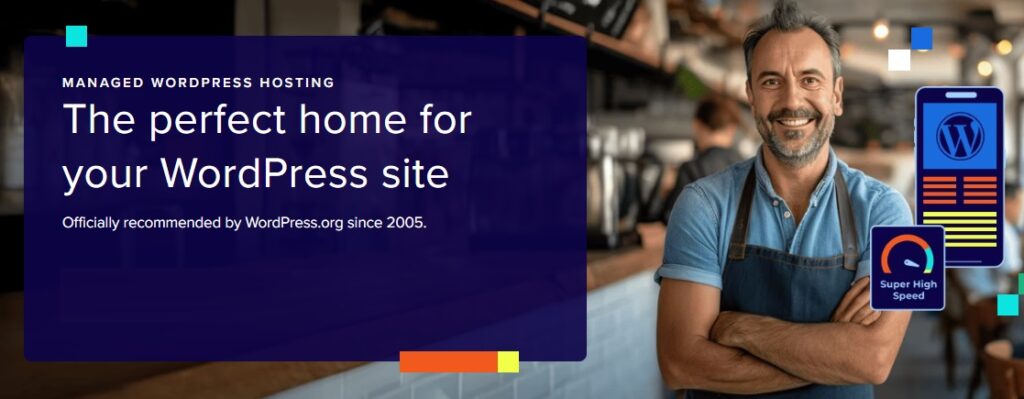
Bluehost, being a premium WordPress hosting provider, helps podcasters create, host and grow professional podcast websites with seamless WordPress integration. We offer reliable hosting and tools designed specifcally for creators.
While Bluehost isn’t a dedicated podcast hosting platform, it provides an ideal foundation for starting a podcast and creating a podcast website.
1. Launch your podcast website with WordPress hosting
We are officially recommended by WordPress, making us one of the best solutions for starting a podcast or building a business podcast website. Our WordPress hosting plans, from shared to managed options, offer:
- One-click WordPress installation for quick setup.
- Free SSL certificates and domain registration to secure your site.
- Customizable themes designed for showcasing episodes, show notes and guest profiles.
With Bluehost WordPress hosting, you can easily embed your audio recordings, display media players and publish blog posts or show notes to boost discoverability. Each new episode can be featured on your site to attract new listeners and keep your target audience engaged.
2. Create and manage your podcast brand
Bluehost offers full design flexibility through WordPress themes and drag-and-drop builders. You can choose from hundreds of podcast-optimized templates, add your logo and match your branding without technical skills. Our WordPress hosting solution is ideal for anyone learning how to create a podcast or grow a consistent online identity.
3. Store and integrate your podcast content
While Bluehost focuses on website hosting, you can upload smaller audio files directly or connect your site to a dedicated podcast host (like Libsyn or Blubrry) for large-scale media delivery.
This hybrid setup ensures fast streaming speeds, smooth playback and scalable performance as your audience grows—whether you’re launching your first show or expanding a business podcast.
4. Scale effortlessly as your audience grows
As your podcast gains traction, Bluehost allows easy upgrades, from shared hosting to VPS or dedicated hosting, to handle more visitors and higher traffic.
This scalability ensures your site remains fast, secure and ready for growth as you improve audio quality, expand your target audience and publish episodes more frequently.
5. Focus on creating great content, not technical issues
With Bluehost, you don’t need to worry about backend setup or maintenance. Features like automatic WordPress updates, 24/7 expert support and built-in SEO tools enable you to spend more time creating and promoting your show.
You can focus on starting a podcast that resonates with your listeners.
Whether you’re launching your first show or taking your existing one to the next level, we offer seamless WordPress integration. Our extensive WordPress hosting and exciting tools simplify how you share your voice with the world. A WordPress website, with ever-fast loading time and your excellent podcast content, your audience will keep coming back for every new episode.
Why 2025 is the year of podcasting: The future of outreach marketing
Podcasting in 2025 is entering its most influential era yet. In the U.S. alone, 55% of the population, around 158 million people, listen to podcasts every month. Globally, the podcast industry is projected to reach $39.63 billion this year, up from $30.72 billion in 2024. The numbers clearly reflect just how promising this medium is proving to be.
As more listeners tune in and more platforms invest in podcast technology, podcasting is becoming one of the most effective ways to reach, educate and engage audiences worldwide.
It blends authenticity with accessibility, a combination that continues to drive its explosive growth in both entertainment and outreach marketing.
The power of connection through podcasting
Podcasting’s strength lies in its personal nature. Listeners feel connected to hosts they trust. This makes the medium an ideal channel for brands, educators and creators who want to build deeper relationships with their audiences. With its ability to foster authenticity, influence purchase decisions, and keep audiences engaged for longer periods, podcasting is now a cornerstone of modern digital marketing.
The importance of the right platform
While many tools can help creators start a podcast, success depends on using a platform that simplifies production, hosting and monetization. The Bluehost WordPress Content Creator Solution delivers just that — offering seamless WordPress integration, customizable podcast website designs, built-in SEO tools, and multiple monetization options.
With these capabilities, content creators can focus on what matters most — creating great podcast content consistently and growing their audience in a rapidly evolving digital landscape.
Final thoughts
This guide walked you through the full journey: why podcasting works for brand building and revenue, the 12-step launch path from concept and format to gear, planning, recording, editing, hosting, directory distribution, website, promotion and monetization. Furthermore, it explores how to measure progress with podcast analytics and publish consistently.
It also showed how Bluehost WordPress hosting fits into your stack: a WordPress-powered home for your show with customizable themes, SEO foundations, reliable performance and easy scaling, paired with a dedicated podcast host when you’re ready for large-scale media delivery.
Put simply, if you define a clear purpose, serve your target audience with valuable episodes and follow the steps here, you can launch a professional podcast that grows reach, trust and revenue, one new episode at a time.
FAQs
Yes, podcasts can make money. You can monetize a podcast with sponsorship deals, ads, affiliate marketing, merchandise sales and paid content.
The cost of starting a podcast varies greatly based on the equipment. For example, you need to pay for a podcast hosting service. You might also need to carry your setup around to interview experts in person, especially people who aren’t in the same town.
Most video podcasts are 30–45 minutes long and 53% of episodes on Buzzsprout are 20-60 minutes long. That’s enough to dive deep into any one podcast topic well. However, there’s no definitive answer here. Episodes can be as long as the topic warrants, but you do need to stay in a certain range, like 30–40 minutes.
A podcast is great for building an audience, so you don’t need one beforehand. Many podcasters will start a podcast with no audience and build it over time.
Track downloads, listener engagement, audience growth, listen-through rate and website traffic to measure success.
Effective methods include sponsorships, affiliate marketing, listener donations (Patreon), merchandise sales and premium content. Keep it relevant to your audience to avoid alienation.
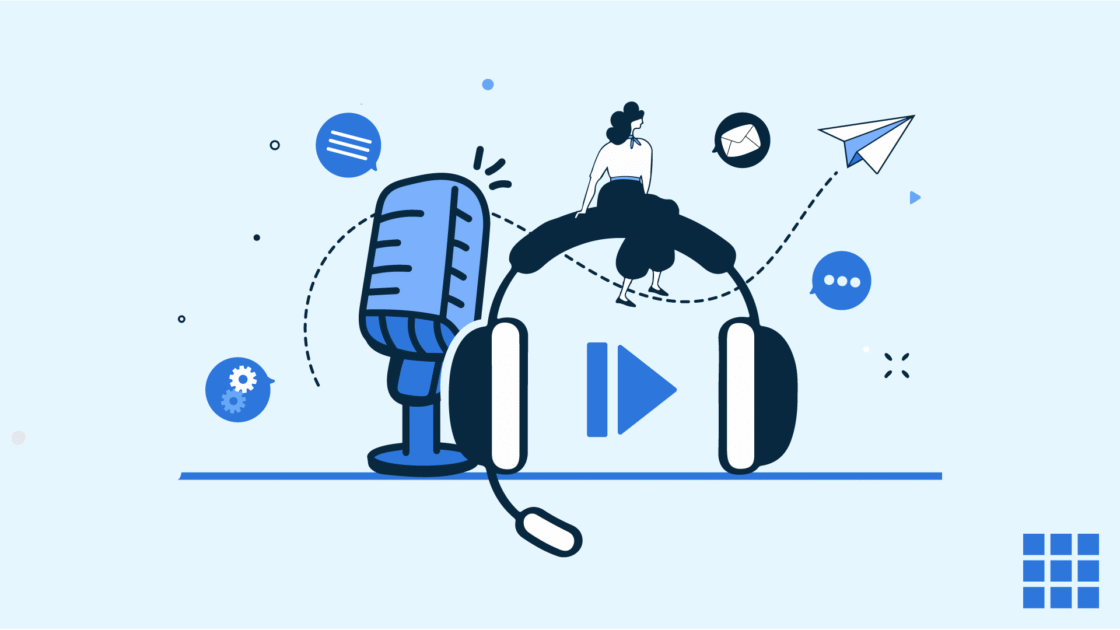


Write A Comment